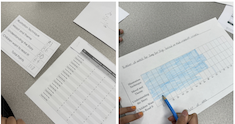I don’t know why I didn’t make time for a Mock Caldecott project earlier in my career. This past year was my second time using a text set of possible contenders from John Schu and Colby Sharp’s Mock Caldecott List Resources.
Typically, I launch projects with a book look—time and space to explore the collection while sitting together on the carpet, informally swapping books with each other. This year I did something different to launch the project by using principal Brian Sammons’s launching PowerPoint that John Schu and Colby Sharp shared in the Mock Caldecott List Resources. I loved the engagement it generated for the whole project and individual books. Brian shares the image of each book and a blurb in 10 or fewer words that reads as a poetic sneak peek. We felt like we were reading clues and a mystery was ahead of us to be solved.
The conversation that emerged had us asking questions about the words and context of the blurb. We noticed authors and illustrators we knew. We noticed one author had two books and discussed why they had a greater chance of winning over other authors. We were excited about book cover illustrations. The next day I had the physical books, and we spent time engaged in a book look session together, which felt more collaborative.
Reading Engagement
I learned from the previous year that it was challenging to hold on to our thinking for each book to determine why we wanted certain titles to win. This year I introduced sketchnoting and made student booklets to hold their thinking. The booklets had a page for each book, with a small picture of its front cover, to help us remember and find our thinking for a specific text later. We looked at the criteria for winning the Caldecott Medal and kept anchoring our thinking discussions daily. I had introduced our voting Google Form earlier in the project this year and had students vote each day right after we read a text. I didn’t realize at this point how much this data collection would impact our literacy work this year.
Writing Engagement
From my initial planning, I envisioned students writing about their predictions for the Caldecott Medal winner and two Caldecott Honor books. This would be a great way to revisit our opinion writing standards. It would also be an authentic way to increase our stamina and look at writing a multiparagraph essay for our state standardized reading test. Last year I did a similar piece of writing and thought my students’ writing lacked voice and specific reasons for their predictions. This year with our thinking captured in our sketchnoting books and completing our voting after each text was read, the writing was more specific and lively. I also created a template with a paragraph-per-page outline to help increase the stamina and find a flow for increased volume of writing.
Math Strengthened Our Thinking and Writing
The students were excited to find out the results from our class voting and see as a class which book was our Caldecott Medal winner. I had a lot of data and needed help putting it together. I thought representing the information in a bar graph would be an authentic way to apply math standards we had previously learned. I then realized that although the numbers in each category on the voting form meant adding single-digit numbers, we would need to add the four category totals for a book total and would be adding up to four two-digit numbers using strategies based on place value and properties of operations. We were highly engaged mathematicians on a mission.
We had our totals and wanted to share them with each other. I remembered an activity from earlier in the year where we lined up silently using our birth dates. We did that again and quickly shared orally the book title and the total votes received for each book.
Before we found out our class total, I had each student write down their top three picks; I didn’t want our class thinking to change or influence their thinking and writing plan. We were surprised to learn that Home in a Lunchbox by Cherry Mo was our top highest total and My Daddy Is a Cowboy by Stephanie Seales was our least. The conversation was a buzz amongst the students with surprise and more wonderings. We made a table to show the points for each of the four categories and posted them in the classroom. We then made bar graphs to display in the hallway and generate excitement for the award announcement the following week.

I was co-teaching with our Gifted coach that day, and together we realized we had to pivot and adjust our data representation as a whole class. Together we realized we needed to take our total range for all the book totals, and we decided to divide it into four smaller range groupings. We then mounted the book covers on the same-size paper background to make an official bar graph. It couldn’t be a picture graph because the images weren’t the same. We were excited for the unexpected twist because we were expanding and authentically using our mathematical vocabulary.
Energy Continued
Our energy and excitement continued as we wrote and published our multiparagraph essays. The students’ writing was stronger and their voices were varied.
“My evidence is the book makes me feel good like delight on a cold rainy day.”
“My evidence is when you see this book you see color like a vibrant swirly rainbow dashing towards you with happiness. Children wanna pick up the book.”
“The painting job was really fantastic. Life After Whale was a really good picture book. With the picture of the whale falling down was really good and for me jaw dropping.”
“The illustrations look real, the illustrations pull you in and make you feel the mood even though the art is made out of acrylics and 3D pencil sketches.”
I wondered how we could share our work on a larger scale and reached out to my school librarian. She helped us publish our writing as podcasts using WeVideo and created a Google Slide with a link to each one for families to view. Not only did this increase our audience, but we had evidence and information about oral reading fluency. Some unplanned joys were discovered too. Students who often spoke in a very soft voice created their podcast with a strong, loud voice. A couple of striving readers were reading multisyllabic words with ease and had inflection in their voices. Parent/teacher conferences were two weeks later, and each family wanted to discuss the Mock Caldecott podcasts.



